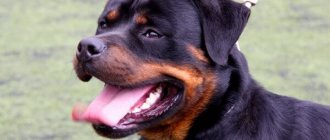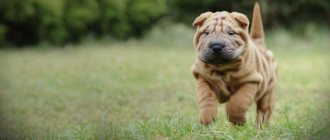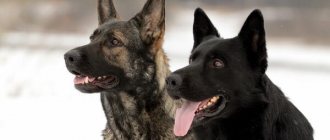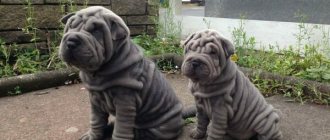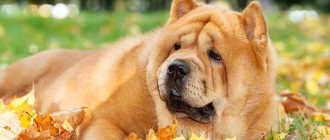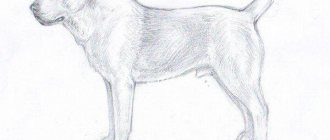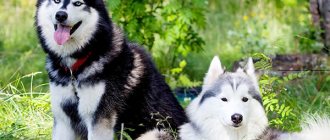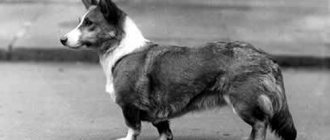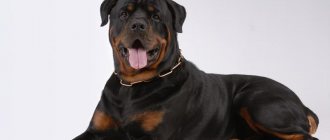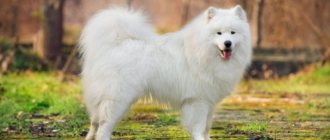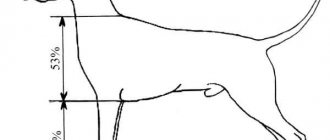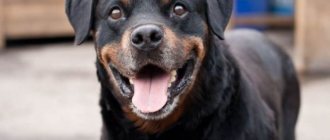Rottweilers are essentially service and guard dogs.
Rottweilers are large dogs with a powerful body and muscles.
Caring for and raising them requires a lot of time and energy.
Not everyone can cope with this breed, because it is not suitable for everyone.
To know if you should get a Rottweiler, it's important to review some basic information about the breed.
Description of pets
Traditionally, males are larger than females in size - larger and heavier . They have a medium-length head, a moderately high forehead line, and pronounced cheekbones.
Dogs have semi-erect triangular ears that form a straight line with the top of the skull. The eye color should be dark brown, and their shape should be almond-shaped (shown in the photo).
Rottweilers have short, coarse hair with an invisible undercoat. The tail in its natural form should extend the line of the back.
The Rottweiler is a fighting dog that requires maximum patience and time from the owner..
This is the smartest dog that is easy to train, but if not properly trained it can be aggressive and even dangerous not only for others, but also for the owner and members of his family.
Evil or good?
The work for which Rottweilers were bred was associated with extreme factors that formed courage, endurance, strength and aggression in these dogs.
Modern Rottweilers are not without these qualities, despite the fact that all breeding work is aimed at producing dogs with a stable psyche and lack of aggression.
The Rottweiler itself is not evil, but at the same time it has a highly developed guard instinct, which causes its aggressive behavior if something seems suspicious to the dog. Only properly raised representatives of the breed who have undergone high-quality training do not have natural cruelty.
IMPORTANT!
It is very important to accustom your Rottweiler to calm behavior in extreme conditions and complete obedience to the owner.
Breed standard
Rottweiler breed standard (example in the picture) :
- Weight. Males must weigh at least 50 kg, females - 40-42 kg.
- Height at the withers. For males it is 61-68 cm, for females – 56-63 cm.
- The color should be black with tan on the face, chest and legs. The color of tans can be any shade of brown - from red to red-brown. Any deviation from this description is a paint defect. A purebred Rottweiler can never be long-haired, have no undercoat, or have a soft, short, wavy coat.
- Lifespan. For Rottweilers it is not long - 8-12 years.
- Character. Rottweilers are determined and brave dogs, but at the same time willful and independent. They are difficult to provoke into aggression. Well-trained dogs will become excellent protectors and watchdogs. To become an authoritative owner for a Rottweiler, the dog’s respect will need to be earned. The RKF standard states that traits such as cowardice, angry and distrustful behavior are regarded as defective character traits.
- Intelligence. These are very smart dogs that are easy to train. They have a good memory and quickly adapt to changing conditions.
- Security and guard potential. Most often, this breed is bred for official purposes. Dogs of this breed are preferred by law enforcement agencies and security forces. Rottweilers perform excellent guard and escort duties, and they also have great abilities in finding explosives and narcotic substances.
Character traits
The Rottweiler is a reliable protector and guard. The dog perceives the family in which he lives as a pack, feels like a part of it and considers it his duty to protect it.
In the family circle they are optimistic, friendly dogs who love games, but they treat strangers with extreme vigilance and wariness. One hint of a threat to the dog is enough to turn into an uncontrollable, aggressive beast, capable of attacking without hesitation at any moment.
Family relationships affect the character and behavior of Rottweilers. With constant scandals and infighting, dogs grow up aggressive and uncontrollable, and Rottweilers raised in love and harmony are loyal friends with a balanced psyche.
Being smart dogs and excellent manipulators, Rottweilers notice all the weaknesses of the owner and, whenever possible, try to take a leading position in the family. Devotion and obedience from them can only be achieved by a person with a strong and decisive character who can earn the pet’s trust and prove his leadership.
Rottweilers are devoted to one owner. If the owner changes, the dog may become depressed, run away, or behave aggressively.
Representatives of this breed need regular active walks, exercise and socialization. Not only their psychological and physical health, but also their level of intelligence depends on this.
Rottweilers are disciplined, attentive, receptive to training, have willpower, intelligence and good memory. At the same time, their stubbornness, self-confidence and ability to make decisions on their own can interfere with training and will require maximum determination, perseverance and consistency from the owner.
Expert opinion
Kozhevin Semyon Kirillovich
Expert dog handler.
Rottweilers are not a breed for amateurs. These dogs need competent education, moderate severity and professional training, otherwise their behavior will be aggressive and uncontrollable. You need to start raising a puppy immediately after purchasing it, and at the age of 8-12 months you should start training according to OKD together with an experienced dog handler. It is necessary to achieve unquestioning obedience, otherwise there will be serious problems with the dog in the future.
What does a puppy look like?
A Rottweiler puppy should generally look like a smaller version of an adult dog (below in the photo) .
He should move confidently, without swaying or limping. Their legs are straight and muscular, parallel to each other.
Up to three months, the puppy's head looks like a small copy of the head of an adult Rottweiler - a wide, short muzzle and a pronounced chin.
During adolescence, the proportions of the head may change.
The ears should be long and reach the middle of the cheekbones . They are triangular in shape and have a high, wide fit.
Until the puppy is one year old, the coat is straight and short, it should not curl. At an early age, it is allowed to be fluffy and soft.
Also, the brown tan on the fur is already quite clearly visible.
Small Rottweilers also have 28 baby teeth and a scissor bite..
Where is the best place to keep it?
The size of the Rottweiler allows it to be kept both in a city apartment, if its area allows, and on the street.
Outdoor keeping presupposes the presence of a spacious enclosure with a booth, where, while observing the territory, the dog can realize its watchdog instinct.
When kept in an enclosure, the dog should be taken into the house when the air temperature drops below -10 °C.
Types of Rottweilers and descriptions
There are four Rottweiler breed standards registered in the world.:
- American.
- German.
- English.
- FCI standard (Federation Cynologique Internationale).
American breeders used German Rottweilers, which had certain deviations, to breed American standard dogs.
These were mainly dogs that were taller than their counterparts and had an aggressive character..
For American reasons, this breed was supposed to inspire fear and look impressive. She must do everything to protect the territory from those who encroach on it.
NOTE!
It is difficult for Rottweilers of the American variety to participate in various exhibitions due to deviations from the FCI standard.
Breeders of the English type Rottweilers also used German representatives of the breed when breeding. These two species are very similar to each other.
The only differences are in character . English Rottweilers, like their owners, are quite reserved and can remain cool in almost any situation. Exceptions are situations when one of the family members is at risk.
When drawing up the standard for the Rottweiler, the International Canine Federation relied specifically on the German type of this breed.
But in addition to the official ones, there are also unofficial types of this breed.
Almost every country had its own approach to breeding Rottweilers..
Rottweilers of the Finnish line have elongated muzzles and ears. This is explained by their crossing with Russian hounds to improve their sense of smell.
In Austria, this breed is used exclusively for military purposes. They are always on army territory and are raised and trained from different ages. This variety is shorter than German Rottweilers, better developed physically and has no subcutaneous fat.
There are no rules in the Italian Rottweiler breeding line. Therefore, they often have dogs with defects and abnormalities.
Italian Rottweilers are often called mini Rottweilers due to their build..
First feeding
The first complementary foods are introduced when the puppy is three weeks old..
It consists of puppies consuming warm cow's milk, which should be added with a chicken egg.
In the first days, one egg is required per glass of milk, and in subsequent days, an egg per 300-300 g . Instead, you can use special breast milk substitutes that are sold in pet stores.
The feeding process should be as close as possible to the natural process.
To do this, the puppy is taken under the chest so that he can “knead” with his front paws and lean on something with his back paws, as when sucking his mother’s milk.
IMPORTANT!
Puppies should be fed twice a day, and then gradually increased to four times a day.
The portion at the beginning of complementary feeding is 100 g, and by the age of one month it reaches 400 g.
Main color
The main color of the Rottweiler is black. Its name is tan.
Tan spots have clearly defined boundaries and are located in certain places:
- On the head in the area of the cheeks and eyebrows.
- Under the larynx.
- In the chest area.
- On shoulders.
- On the inner thighs.
- In the anal area.
- At the bottom of the paws.
Possible complications
The most common problem after cupping is scarring. Unsightly healed edges of the ears or tail make the dog less attractive.
When using non-sterile devices, blood poisoning and the appearance of an abscess at the incision site may occur. Any inflammation is a bait for infections, because local immunity is sharply weakened.
Interesting! It is believed that an animal with a docked tail is less sensitive and more aggressive. The dog cannot show emotions like other dogs, so it has poor contact with others.
Popular colors
Deviation from the norm of color is a defect. Such dogs cannot participate in exhibitions, but are very popular with ordinary owners.
Common colors among Rottweilers include red, golden , brown, black without tan and albino. These colors appear either due to a genetic abnormality or are an inheritance from ancestors.
Dishonest breeders use such dogs, cross them and pass them off as unique, raising their prices several times over.
Dogs of non-standard color differ from others not only in coat color, but also in size, shade and tan boundaries . It may be completely absent on the face, or it may be lighter and have white spots.
Content
The best place for a dog to live will be a spacious enclosure in the yard. To prevent your pet from freezing in winter, make wooden flooring from sanded boards.
In apartments, a bed is made from blankets and pillows; you can see how to do this easily, quickly and at no cost on the homemade portal https://mastersamodelok.ru/. You can entertain your pet by giving him squeaky balls, rubber bones, rings and other “chews”.
For walks, you need to acquire special equipment - a leash, muzzle, collar. Walking time should be at least 3 hours.
What are the differences between boys and girls?
There are big differences between males and females in this breed.
Perhaps the most important difference is the size and weight. Males are larger and larger, females are smaller and more compact. This difference is easy to determine by eye.
Males are more aggressive than females and are stubborn . Therefore, males are suitable for experienced dog owners, and females are suitable for beginners, because they are more flexible.
But this does not mean that the future owner does not need leadership qualities. In any case, bitches become more attached to a person and learn better.
CAREFULLY!
The disadvantages of females include the period of estrus, and males tend to run after females during this period.
The owner of the bitch will also have to deal with the animal's pregnancy and childbirth.
Feeding
Above we mentioned super-premium food. You can buy special food made taking into account the characteristics of the breed. Or you can simply choose universal food. It must be of high quality - this is the path to a healthy dog.
A good super-premium food (holistic) costs about 6,000 rubles. Quite an impressive amount for a bag that will last for a month. But if you calculate how much money will be spent on natural products, then it is cheaper to buy high-quality food. At least it's completely balanced.
Have you decided to feed “natural”? We list here the necessary products:
- Lean meat: veal, turkey, beef. Chicken can cause allergies; its introduction into the diet should be approached carefully.
- Vegetables are a side dish for meat.
- The main grains given to dogs are rice and oatmeal.
- Sea fish is lean, boneless.
- Dairy products: cottage cheese, kefir, cheese.
- Boiled eggs.
- Fruits: apples, unsweetened pears.
- Offal.
- Crackers made from black and wheat bread as a delicacy.
An adult pet is fed twice a day. In the morning and in the evening.
Representatives of the breed are prone to obesity. Be careful not to overfeed your dog. His ribs should be palpable. If, by placing his hand on the dog’s ribs, the owner discovers a thick layer of fat, it’s time to reconsider his diet. And make adjustments to the single portion, reducing it.
Why is the tail docked?
Nowadays, Rottweilers with regular tails are quite common, but previously, due to the fact that they performed various dangerous tasks, their tails were docked to reduce the risk of injury from other animals.
Currently, tail docking is an optional procedure . It is done only to improve the appearance of the dog.
Cupping is usually done within 10 days after birth, while the vertebrae have not yet ossified.
Vaccinations
The lifespan of a large breed dog is about 8-10 years. Sometimes this figure can increase for another 3-4 years. Due to their brutal appearance and fairly large build, Rottweilers give the impression of being strong and hardy. However, this breed of dog has plenty of its own diseases.
Innate immunity acquired through mother's milk protects the puppy for up to two months after birth. Further, starting from the age of two months, it is necessary to develop the acquired immunity of the dog through timely vaccination.
This measure will further help protect not only the dog’s body from various types of diseases, but will also protect the household members themselves from possible health problems. Agree, an unvaccinated dog infected, for example, with rabies, will pose a threat to others .
The vaccine is usually placed either in the scruff of the neck or in the hip of the puppy. For each dog, the veterinarian creates a special medical passport, which records all the procedures performed. According to the vaccination rules, Rottweiler puppies must be vaccinated against:
- rabies;
- adenovirus;
- leptospirosis;
- parainfluenza virus;
- parvovirus enteritis.
The first vaccination for a puppy is carried out at the age of 6-8 weeks. This is usually done by breeders, so most likely your puppy will already have his first vaccination. Booster vaccinations will be needed every three weeks until the puppy is 20 weeks old. Further, up to two years, revaccination is done against plague, parvovirus and parainfluenza virus.
Are ears cropped?
Rottweilers with cropped ears are a real rarity.
For this breed, such operations are almost never carried out. An exception may be ear lesions.
According to the standard, the ears of Rottweilers should be hanging and close to the muzzle.
Ear cropping
The operation is not complicated, it has been carried out for a long time, so veterinarians know all the intricacies. The main thing is to ensure the sterility of the instruments and the procedure site. You can invite a doctor to your home.
Ears are always cropped using local or general anesthesia. The Rottweiler is fixed on a flat surface (operating table, couch): the dog is laid on its side, the hind and front limbs are tied, and a hygienic fabric muzzle is put on the muzzle.
An inhalation tube is installed for artificial ventilation and tongue control. The ears are placed on the table and secured with patterns along the cut line. Metal forms not only serve as a template, they reliably clamp the vessels of the cropped ears.
The skin is moved to the base, an incision is made with a scalpel according to the attached template. The cut edge is treated with an antiseptic, stitches and a corrective bandage are applied.
How to choose?
Knowing all the behavioral features and character of this breed, we can conclude that it is not suitable for everyone and certainly not for a beginner.
But if you are confident in your abilities, then before choosing a puppy, you need to familiarize yourself with some tips that will help you choose a healthy pet:
- Give preference to a curious puppy who does not hide, but rather licks your fingers and sniffs you.
- Ask the Rottweiler breeder to see the litter's parents. If he gives you unhindered access to the dogs, then there is nothing to be afraid of, but if not, then this is a reason to think about it.
- Observe the puppies' parents. Basically, they will inherit their qualities.
- Ask the breeder to confirm how many times the mother of the puppies has been bred. Rottweilers are prone to severe genetic diseases. It is best if the puppy is born at 1-3 gestation, and the mother is 2-5 years old. These indicators will reduce the tendency of diseases to a minimum.
- The most severe hereditary disease is hip dysplasia. It appears in dogs 2-3 months after birth. To be sure of the puppy’s health, ask the breeder for documents confirming that neither the puppy nor its parents have this disease.
- Ask any questions you have to the breeder. Watch how he answers them.
- Remember that a conscientious breeder will always ask for what purpose you are getting a dog and in what conditions the puppy will be kept.
Also pay attention to the general condition of the dog.
Even externally, the puppy should look healthy, well-fed, cheerful and active, without any flaws.
His coat should be clean, smooth and shiny, his teeth should be white and his gums should be pink..
Physiological processes in the dog's body
Biochemical processes
There are only two pigments in the dog’s body, which are found in the skin and hairs of the animal:
- pheomelanin - responsible for yellow color and its variations: red, red;
- eumelanin is responsible for the black color, which in its mutation form provides a brown color of varying intensity.
The pigments that determine a dog's color are located inside each hair. Their quantity, a certain color and the shape of the granule in which they are contained determine the color of the pile.
Genetic processes
A gene is a hereditary unit that conveys the characteristic characteristics of a breed.
Genotype is the basis of a dog’s body, a combination of hereditary factors and all genes.
Phenotype is the color of an animal formed by its genotype.
An allele is a state of the same gene under the influence of other genes.
Each gene is assigned its own letter designation: A, B, C, and so on. Let's look at the main genes that are responsible for all colors in Rottweiler dogs:
- at – responsible for the development of tan spots;
- asa – promotes the manifestation of non-standard black-and-white color;
- B – responsible for the appearance of black;
- b – promotes the appearance of a non-standard brown color in tan marks;
- C – full color of normal intensity;
- D – responsible for pigmentation density;
- E – promotes uniform distribution of black color throughout the animal’s body;
- Em – promotes the appearance of non-standard blackness of tan spots;
- g – is responsible for blocking age-related lightening;
- kbr – promotes the manifestation of non-standard brindle color;
- k – responsible for the location of genes;
- s – promotes the appearance of white spots.
If you liked the article, please share it with your friends and like it.
Origin story
The ancestors of the Rottweiler are considered to be Molosser-like dogs that served the Roman legionnaires. They guarded convoys and were even used as fighting dogs, as can be seen in the pictures of those times. With Roman troops they entered Germany. There, strong, efficient dogs took root and began to be used for herding cattle and guarding.
The modern Rottweiler became known as an independent breed of dog in the 18th century. It was bred in the German town of Rottweil. Mastiffs were crossed with local herding dogs. The purpose of breeding was to obtain an obedient and hardy dog. These strong, efficient animals were used to guard carts of meat, sometimes even harnessing them to carts. Therefore, at first they were called “butcher’s dogs.” Then the name rottweiler appeared.
In the 19th century, with the advent of the railroad, the need for such helpers disappeared, and Rottweilers almost disappeared. But gradually the fame of this dog as the best protector and guard spread throughout the country, and then throughout Europe. At the beginning of the 20th century, representatives of this breed were brought to Russia. At first, Rottweilers were used for herding livestock and in police service. Then they began to breed more evil individuals to guard prisoners in the camps.
Since the 20s of the 20th century, the Rottweiler breed has received official recognition as a service dog. According to the ICF classification, they were classified as Molossers, a subsection of Mastiffs. In Europe, Rottweilers were bred as pets, paying more attention to such characteristics as loyalty and goodwill.
In Russia, evil guards and guard dogs were bred, which gained fame as rude and aggressive dogs. Only in the 80s did representatives of the breed with a calm, peaceful character appear, brought from Germany. Now Rottweilers are one of the most popular dog breeds all over the world.
Interesting Facts
There are many interesting things associated with the Rottweiler breed. Here are just some facts:
- According to historical data, dogs resembling modern representatives of the breed took part in the Seven Years' War - one of the largest armed conflicts of the 18th century.
- In the old days, German butchers hung purses around the necks of their dogs. No one in their right mind would risk robbing a four-legged defender.
- Rottweilers are prohibited from being imported into some countries because they are considered potentially dangerous. The list includes Israel, Bermuda, Portugal, Ecuador.
